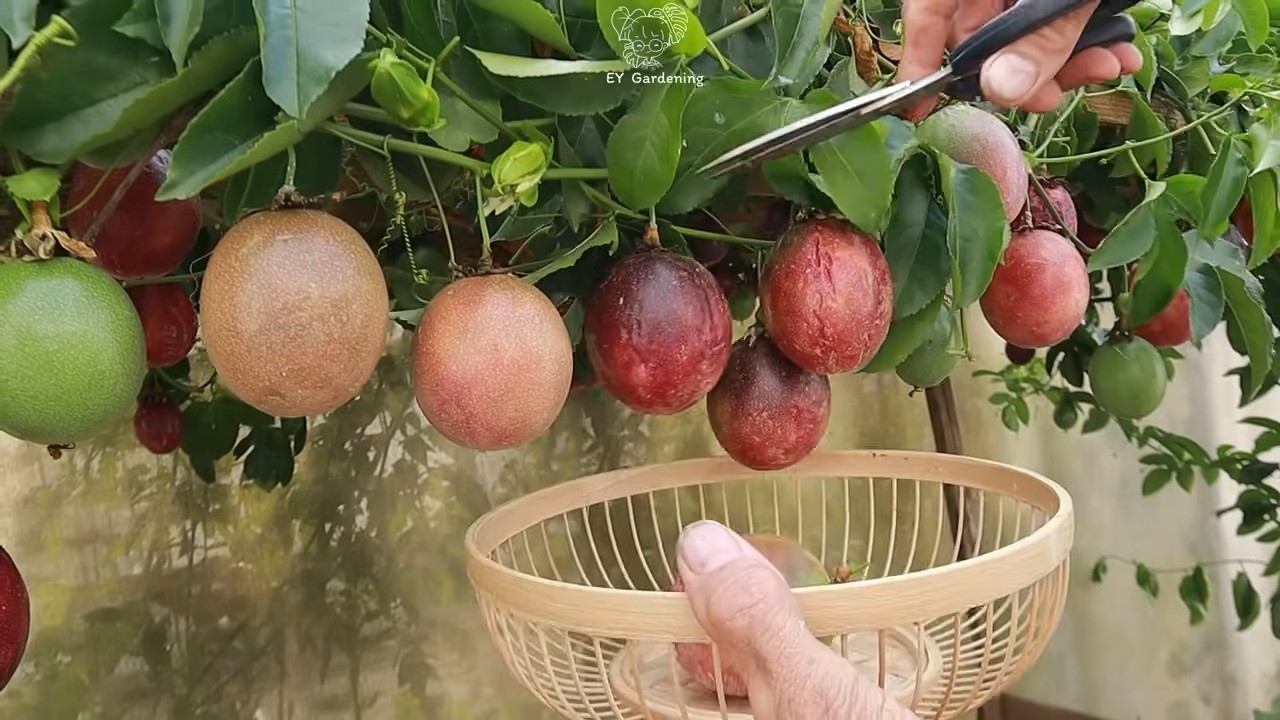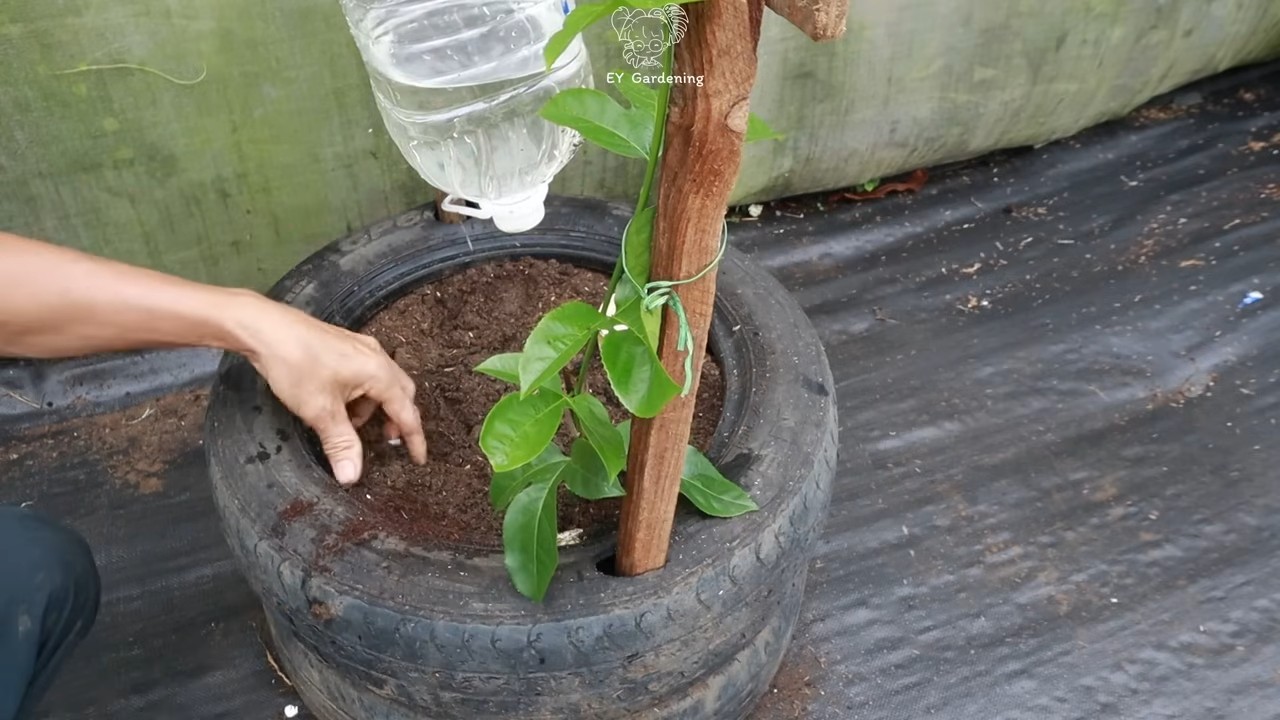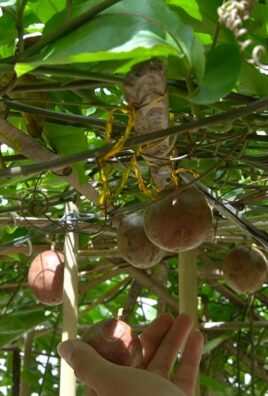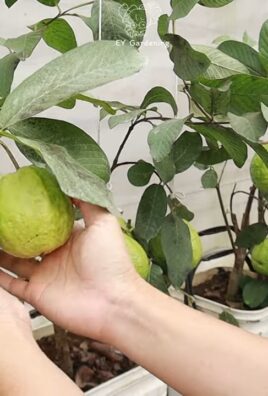Grow Passion Fruit at Home and transform your backyard into a tropical paradise! Imagine plucking juicy, fragrant passion fruit straight from your own vine – a taste of the exotic right at your fingertips. But let’s be honest, the idea of cultivating this vibrant fruit can seem a little daunting, right? That’s where this DIY guide comes in!
For centuries, passion fruit has been cherished in South America, not just for its delectable flavor but also for its purported medicinal properties. Indigenous cultures have long used its leaves and flowers in traditional remedies. Today, its popularity has exploded worldwide, gracing everything from desserts to cocktails.
Why should you embark on this passion fruit adventure? Well, store-bought passion fruit can be expensive and sometimes lack that fresh, vibrant taste. Plus, grow passion fruit at home is incredibly rewarding! Not only will you have a constant supply of delicious fruit, but you’ll also enjoy the beauty of the vine itself, with its stunning flowers and lush foliage. This DIY project is perfect for anyone looking to add a touch of the tropics to their garden and enjoy the satisfaction of growing their own food. Let’s dive in and unlock the secrets to successfully cultivating passion fruit in your own backyard!

Grow Your Own Passion Fruit Paradise: A DIY Guide
Hey there, fellow plant enthusiasts! Ever dreamt of sipping on a refreshing passion fruit juice made with fruit you grew yourself? Well, dream no more! Growing passion fruit at home is totally achievable, even if you don’t have a sprawling garden. I’m going to walk you through everything you need to know, from choosing the right variety to harvesting your delicious bounty. Let’s get started!
Choosing Your Passion Fruit Variety
Not all passion fruit are created equal! Different varieties thrive in different climates, so picking the right one is crucial for success. Here’s a quick rundown of some popular choices:
* Purple Passion Fruit (Passiflora edulis): This is the most common variety, known for its tart and aromatic flavor. It’s best suited for warmer climates (USDA zones 9-11) but can be grown in containers in cooler areas and brought indoors during winter.
* Yellow Passion Fruit (Passiflora edulis flavicarpa): This variety is more tropical and prefers hotter, more humid conditions. The fruit is larger and more acidic than the purple variety.
* Sweet Granadilla (Passiflora ligularis): If you prefer a sweeter, less acidic passion fruit, this is the one for you! It’s also a bit more cold-tolerant than the other two.
* Hybrid Varieties: Many nurseries offer hybrid passion fruit varieties that combine the best traits of different species. These are often more disease-resistant and productive.
My Recommendation: If you’re a beginner, I’d suggest starting with the purple passion fruit. It’s relatively easy to grow and widely available.
Setting Up Your Passion Fruit Vine
Passion fruit vines are climbers, so they need a sturdy support structure to grow on. Here’s how to set up the perfect trellis:
* Choose a Sunny Location: Passion fruit vines need at least 6-8 hours of direct sunlight per day to thrive.
* Select a Trellis: You can use a variety of structures, such as a fence, pergola, arbor, or even a sturdy wire trellis. Make sure it’s strong enough to support the weight of a mature vine.
* Consider Container Growing: If you live in a cooler climate, growing your passion fruit in a container is a great option. Choose a large pot (at least 20 gallons) with good drainage.
Planting Your Passion Fruit Vine
Now for the fun part – planting! Here’s a step-by-step guide:
1. Prepare the Soil: Passion fruit vines prefer well-draining soil that’s rich in organic matter. Amend your soil with compost or well-rotted manure before planting.
2. Dig a Hole: Dig a hole that’s twice as wide and as deep as the root ball of your passion fruit plant.
3. Plant the Vine: Gently remove the plant from its container and loosen the roots. Place the plant in the hole, making sure the top of the root ball is level with the ground.
4. Backfill the Hole: Fill the hole with soil and gently firm it around the plant.
5. Water Thoroughly: Water the plant deeply after planting to help it settle in.
6. Mulch: Apply a layer of mulch around the base of the plant to help retain moisture and suppress weeds.
Caring for Your Passion Fruit Vine
Once your passion fruit vine is planted, it’s important to provide it with the proper care to ensure healthy growth and abundant fruit production.
* Watering: Water your passion fruit vine regularly, especially during dry periods. The soil should be kept consistently moist, but not waterlogged.
* Fertilizing: Feed your passion fruit vine with a balanced fertilizer every 4-6 weeks during the growing season. Look for a fertilizer that’s specifically formulated for fruit-bearing plants.
* Pruning: Prune your passion fruit vine regularly to encourage branching and fruit production. Remove any dead, damaged, or diseased growth. You can also prune back the vine to control its size and shape.
* Pest and Disease Control: Passion fruit vines can be susceptible to pests such as aphids, spider mites, and scale. Inspect your vine regularly and treat any infestations promptly. They can also be affected by fungal diseases, so ensure good air circulation and avoid overwatering.
Training Your Passion Fruit Vine
Training your passion fruit vine to grow along your trellis is essential for maximizing fruit production and keeping the vine manageable.
1. Guide the Vine: As the vine grows, gently guide the stems along the trellis, using plant ties or twine to secure them in place.
2. Encourage Branching: Pinch off the tips of the main stems to encourage branching. This will create a fuller, more productive vine.
3. Remove Suckers: Remove any suckers that grow from the base of the plant. These will steal nutrients from the main vine.
Pollinating Your Passion Fruit Flowers
Passion fruit flowers are beautiful and fragrant, but they need to be pollinated in order to produce fruit.
* Hand Pollination: If you’re not seeing a lot of bees or other pollinators in your garden, you may need to hand-pollinate your passion fruit flowers. Use a small paintbrush to transfer pollen from the anthers (the male part of the flower) to the stigma (the female part of the flower).
* Attract Pollinators: Plant flowers that attract bees and other pollinators near your passion fruit vine. Some good choices include lavender, salvia, and borage.
Harvesting Your Passion Fruit
The moment you’ve been waiting for! Here’s how to harvest your passion fruit:
1. Wait for the Fruit to Ripen: Passion fruit are ripe when they change color and fall from the vine. The skin may be slightly wrinkled.
2. Pick Up the Fruit: Simply pick up the fallen fruit from the ground.
3. Enjoy! You can eat the pulp straight from the fruit, or use it to make juice, smoothies, desserts, and more.
Troubleshooting Common Problems
Even with the best care, you may encounter some problems when growing passion fruit. Here are some common issues and how to address them:
* Lack of Fruit: This could be due to a lack of pollination, insufficient sunlight, or nutrient deficiencies. Make sure your vine is getting enough sunlight, fertilize it regularly, and hand-pollinate the flowers if necessary.
* Yellowing Leaves: This could be a sign of overwatering, nutrient deficiencies, or pest infestations. Check the soil moisture and adjust your watering accordingly. Fertilize the vine with a balanced fertilizer and inspect it for pests.
* Leaf Spot: This is a fungal disease that can cause brown spots on the leaves. Improve air circulation around the vine and treat it with a fungicide if necessary.
Passion Fruit in Containers: A Special Note
Growing passion fruit in containers is a fantastic option, especially if you live in a cooler climate. Here are some extra tips for container growing:
* Choose the Right Pot: Select a large pot (at least 20 gallons) with good drainage.
* Use a Well-Draining Potting Mix: Avoid using garden soil in containers, as it can become compacted and poorly drained. Use a high-quality potting mix that’s specifically formulated for containers.
* Water Regularly: Container plants tend to dry out more quickly than plants in the ground, so water your passion fruit vine regularly.
* Fertilize More Frequently: Container plants also need to be fertilized more frequently, as nutrients can leach out of the soil more easily.
* Overwintering: If you live in a cooler climate, bring your passion fruit vine indoors during the winter. Place it in a sunny location and water it sparingly.
Propagating Passion Fruit
Want to expand your passion fruit patch? Here’s how to propagate new plants:
* From Seed: You can grow passion fruit from seed, but it can be a bit tricky. Soak the seeds in water for 24 hours before planting them in a well-draining potting mix. Keep the soil moist and warm, and be patient – it can take several weeks for the seeds to germinate.
* From Cuttings: A more reliable method is to propagate passion fruit from cuttings. Take a 6-8 inch cutting from a healthy stem and remove the lower leaves. Dip the cut end in rooting hormone and plant it in a well-draining potting mix. Keep the soil moist and warm, and the cutting should root in a few weeks.
Enjoying Your Homegrown Passion Fruit
Congratulations! You’ve successfully grown your own passion fruit. Now it’s time to enjoy the fruits of your labor. Here are some ideas:
* Eat it Fresh: Simply cut the passion fruit in half and scoop out the pulp with a spoon.
* Make Juice: Blend the pulp with water and strain out the seeds. Add sugar or honey to taste.
* Add it to

Conclusion
So, there you have it! Growing passion fruit at home isn’t just a whimsical dream; it’s a tangible reality within your reach. We’ve walked through the steps, demystified the process, and armed you with the knowledge to cultivate your own vibrant, tropical oasis, right in your backyard or even on your balcony.
Why is this DIY trick a must-try? Because it offers a unique blend of satisfaction, sustainability, and delicious rewards. Imagine plucking your own sun-ripened passion fruit, bursting with tangy-sweet flavor, knowing you nurtured it from a tiny seed or cutting. It’s a connection to nature, a step towards self-sufficiency, and a conversation starter all rolled into one. Plus, store-bought passion fruit can be expensive and sometimes lacking in the intense flavor of homegrown varieties. This way, you control the quality and freshness, ensuring the most delectable experience possible.
But the journey doesn’t end here! Feel free to experiment and personalize your passion fruit growing adventure. Consider these variations:
* Vertical Gardening: If space is limited, train your passion fruit vine to climb a trellis, fence, or even a wall. This not only saves space but also creates a stunning visual display.
* Container Gardening: Choose a large pot with excellent drainage and use a high-quality potting mix. This allows you to move your passion fruit vine indoors during colder months in regions with harsh winters.
* Grafting: For faster fruiting and disease resistance, explore grafting your passion fruit scion onto a hardy rootstock. This is a more advanced technique but can yield impressive results.
* Different Varieties: Don’t limit yourself to just one type of passion fruit! Explore different varieties like ‘Frederick’ (a popular purple variety), ‘Golden Giant’ (known for its large, yellow fruit), or ‘Panama Red’ (a red-skinned variety with a unique flavor). Each variety offers a slightly different taste and growing experience.
* Companion Planting: Plant beneficial herbs and flowers around your passion fruit vine to attract pollinators and deter pests. Marigolds, basil, and lavender are excellent choices.
Ultimately, the best way to learn is by doing. Don’t be afraid to get your hands dirty, experiment with different techniques, and adapt the process to your specific environment and preferences. The joy of growing passion fruit at home lies not just in the final product but also in the journey of learning and discovery.
We wholeheartedly encourage you to embark on this exciting adventure. Start small, be patient, and don’t be discouraged by occasional setbacks. Remember, every gardener faces challenges, and the key is to learn from your mistakes and keep moving forward.
And most importantly, we want to hear about your experiences! Share your tips, tricks, and triumphs with us. Post photos of your passion fruit vines, describe the unique flavors of your homegrown fruit, and let us know what worked (and what didn’t) for you. Together, we can create a thriving community of passion fruit enthusiasts, sharing knowledge and inspiring others to embrace the joy of growing their own food. So, go ahead, give it a try, and let the passion fruit adventure begin!
Frequently Asked Questions (FAQ)
What is the best time of year to plant passion fruit?
The best time to plant passion fruit is typically in the spring or early summer, after the last frost has passed. This allows the plant to establish itself during the warmer months and develop a strong root system before the onset of winter. However, in warmer climates with mild winters, you can plant passion fruit year-round. The key is to avoid planting during periods of extreme heat or cold.
How long does it take for passion fruit to fruit?
Passion fruit vines typically take 12-18 months to produce fruit from seed. Grafted plants, however, can fruit much sooner, sometimes within 6-12 months. The exact time frame depends on several factors, including the variety of passion fruit, the growing conditions, and the overall health of the plant. Be patient and provide your vine with the proper care, and you’ll be rewarded with delicious fruit in due time.
What kind of soil does passion fruit need?
Passion fruit vines thrive in well-draining soil that is rich in organic matter. A slightly acidic to neutral pH (around 6.0-7.0) is ideal. Amend your soil with compost, aged manure, or other organic materials to improve drainage, fertility, and water retention. Avoid heavy clay soils, as they can become waterlogged and lead to root rot. If you’re growing passion fruit in containers, use a high-quality potting mix specifically formulated for fruiting plants.
How much sunlight does passion fruit need?
Passion fruit vines require at least 6-8 hours of direct sunlight per day to produce abundant fruit. Choose a location that receives full sun for optimal growth and flowering. In hotter climates, some afternoon shade may be beneficial to prevent the leaves from scorching. If you’re growing passion fruit indoors, provide supplemental lighting with grow lights to ensure adequate sunlight exposure.
How often should I water my passion fruit vine?
Water your passion fruit vine regularly, especially during dry periods. Keep the soil consistently moist but not waterlogged. Water deeply whenever the top inch of soil feels dry to the touch. Avoid overwatering, as this can lead to root rot. During the winter months, reduce watering frequency as the plant’s growth slows down.
What kind of fertilizer should I use for passion fruit?
Feed your passion fruit vine with a balanced fertilizer specifically formulated for fruiting plants. A fertilizer with an NPK ratio of 10-10-10 or 14-14-14 is a good starting point. Apply fertilizer according to the manufacturer’s instructions, typically every 4-6 weeks during the growing season. You can also supplement with organic fertilizers like compost tea or fish emulsion. Avoid over-fertilizing, as this can burn the roots and harm the plant.
How do I prune my passion fruit vine?
Pruning is essential for maintaining the health and productivity of your passion fruit vine. Prune regularly to remove dead, diseased, or crossing branches. You can also prune to control the size and shape of the vine. The best time to prune is after the main fruiting season. Avoid heavy pruning, as this can reduce fruit production.
What are some common pests and diseases that affect passion fruit?
Passion fruit vines can be susceptible to various pests and diseases, including aphids, spider mites, scale insects, fruit flies, and fungal diseases like fusarium wilt and anthracnose. Monitor your vine regularly for signs of infestation or disease. Treat pests with insecticidal soap or neem oil. Prevent fungal diseases by providing good air circulation and avoiding overwatering. Remove and destroy any infected plant material to prevent the spread of disease.
How do I know when passion fruit is ripe?
Passion fruit is ripe when the fruit changes color from green to purple, yellow, or red, depending on the variety. The fruit will also become slightly wrinkled and have a fragrant aroma. Ripe passion fruit will fall from the vine naturally, but you can also gently pluck it when it’s ready.
Can I grow passion fruit from seed?
Yes, you can grow passion fruit from seed, but it may take longer to fruit compared to grafted plants. Soak the seeds in warm water for 24 hours before planting to improve germination rates. Plant the seeds in a well-draining potting mix and keep them moist. Germination typically takes 2-4 weeks. Once the seedlings are large enough to handle, transplant them into individual pots.




Leave a Comment